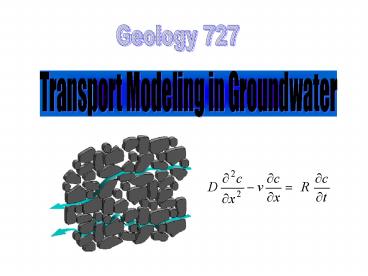Subsurface Hydrology - PowerPoint PPT Presentation
Title:
Subsurface Hydrology
Description:
Subsurface Hydrology Subsurface Hydrology K = Kxx Kxy Kxz Kyx Kyy Kyz Kzx Kzy Kzz Principal components of K q = - K grad h Darcy s law grad h q ... – PowerPoint PPT presentation
Number of Views:200
Avg rating:3.0/5.0
Title: Subsurface Hydrology
1
Geology 727
Transport Modeling in Groundwater
2
Subsurface Hydrology
Unsaturated Zone Hydrology
Groundwater Hydrology
(Hydrogeology)
3
R P - ET - RO
ET
ET
P
E
RO
R
waste
Water Table
Groundwater
4
- Processes we need to model
- Groundwater flow
- calculate both heads and flows (q)
- Solute transport requires information on flow
(velocities) - calculate concentrations
Darcys law
5
- Types of Models
- Physical (e.g., sand tank)
- Analog (electric analog, Hele-Shaw)
- Mathematical
6
- Types of Solutions of Mathematical Models
- Analytical Solutions h f(x,y,z,t)
- (example Theis eqn.)
- Numerical Solutions
- Finite difference methods
- Finite element methods
- Analytic Element Methods (AEM)
7
- Finite difference models
- may be solved using
- a computer programs (e.g., a FORTRAN program)
- a spreadsheet (e.g., EXCEL)
8
- Components of a Mathematical Model
- Governing Equation
- Boundary Conditions
- Initial conditions (for transient problems)
In full solute transport problems, we have
two mathematical models one for flow and one
for transport.
The governing equation for solute transport
problems is the advection-dispersion equation.
9
- Flow Code MODFLOW
- ? USGS code
- ? finite difference code to solve the groundwater
flow equation - MODFLOW 88
- MODFLOW 96
- MODFLOW 2000
10
- Transport Code MT3DMS
- ? Univ. of Alabama
- ? finite difference code to solve the
advection-dispersion eqn. - Links to MODFLOW
11
The pre- and post-processor Groundwater
Vistas links and runs MODFLOW and MT3DMS.
12
Introduction to solute transport
modeling and Review of the governing equation
for groundwater flow
13
Conceptual Model A descriptive
representation of a groundwater system that
incorporates an interpretation of the geological,
hydrological, and geochemical conditions,
including information about the boundaries of the
problem domain.
14
Toth Problem
Head specified along the water table
Groundwater divide
Groundwater divide
Homogeneous, isotropic aquifer
Impermeable Rock
2D, steady state
15
Toth Problem with contaminant source
Contaminant source
Homogeneous, isotropic aquifer
Groundwater divide
Groundwater divide
Impermeable Rock
2D, steady state
16
- Processes to model
- Groundwater flow
- Transport
- Particle tracking requires velocities and a
particle tracking code. calculate path
lines - (b) Full solute transport requires velocites
and a solute transport model. calculate
concentrations
17
Topo-Drive Finite element model of a version of
the Toth Problem for regional flow in cross
section. Includes a groundwater flow model with
particle tracking.
18
Toth Problem with contaminant source
Contaminant source
Groundwater divide
Groundwater divide
advection-dispersion eqn
Impermeable Rock
2D, steady state
19
- Processes we need to model
- Groundwater flow
- calculate both heads and flows (q)
- Solute transport requires information on flow
(velocities) - calculate concentrations
Requires a flow model and a solute transport
model.
20
Groundwater flow is described by Darcys
law. This type of flow is known as advection.
Linear flow paths assumed in Darcys law
True flow paths
The deviation of flow paths from the linear Darcy
paths is known as dispersion.
Figures from Hornberger et al. (1998)
21
In addition to advection, we need to consider two
other processes in transport problems.
- Dispersion
- Chemical reactions
22
Change in concentration with time
- is porosity
- D is dispersion coefficient
- v is velocity.
23
advection-dispersion equation
groundwater flow equation
24
advection-dispersion equation
groundwater flow equation
25
Flow Equation
1D, transient flow homogeneous, isotropic,
confined aquifer no sink/source term
Transport Equation
Uniform 1D flow longitudinal dispersion No
sink/source term retardation
26
Flow Equation
1D, transient flow homogeneous, isotropic,
confined aquifer no sink/source term
Transport Equation
Uniform 1D flow longitudinal dispersion No
sink/source term retardation
27
Assumption of the Equivalent Porous Medium (epm)
REV
Representative Elementary Volume
28
Dual Porosity Medium
Figure from Freeze Cherry (1979)
29
Review of the derivation of the governing
equation for groundwater flow
30
General governing equation for groundwater flow
Kx, Ky, Kz are components of the hydraulic
conductivity tensor.
Specific Storage Ss ?V / (?x ?y ?z ?h)
31
Law of Mass Balance Darcys Law
Governing Equation for Groundwater Flow
-------------------------------------------------
-------------- div q - Ss (?h ??t) R
(Law of Mass Balance) q - K grad h
(Darcys Law) div (K grad h)
Ss (?h ??t) R
32
Darcy column
?h/L grad h
Q is proportional to grad h
q Q/A
Figure taken from Hornberger et al. (1998)
33
q - K grad h
K is a tensor with 9 components
34
Kxx Kxy Kxz Kyx Kyy Kyz Kzx Kzy Kzz
K
35
Darcys law
q - K grad h
q
equipotential line
grad h
grad h
q
Isotropic Kx Ky Kz K
Anisotropic Kx, Ky, Kz
36
q - K grad h
37
global
local
z
z
x
?
x
Kxx Kxy Kxz Kyx Kyy Kyz Kzx Kzy Kzz
Kx 0 0 0 Ky 0 0 0 Kz
K R-1 K R
38
(No Transcript)
39
(No Transcript)
40
Law of Mass Balance Darcys Law
Governing Equation for Groundwater Flow
-------------------------------------------------
-------------- div q - Ss (?h ??t) R
(Law of Mass Balance) q - K grad h
(Darcys Law) div (K grad h)
Ss (?h ??t) R
41
OUT IN
?x ?y ?z
change in storage
- ?V/ ?t
Ss ?V / (?x ?y ?z ?h)
42
OUT IN
- ?V
?t
43
Law of Mass Balance Darcys Law
Governing Equation for Groundwater Flow
-------------------------------------------------
-------------- div q - Ss (?h ??t) W
(Law of Mass Balance) q - K grad h
(Darcys Law) div (K grad h)
Ss (?h ??t) W
44
Storage coefficient (S) is either storativity or
specific yield. S Ss b T K b































